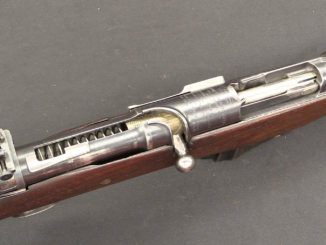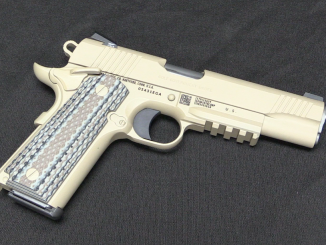Rollin White was the inventor who patented the bored-through cylinder in the US, and sold an exclusive right to this patent to Smith & Wesson. They would use it as the basis for their own work with self-contained cartridges (White’s patent was originally intended as a way to load paper cartridges form the rear of the cylinder), but when the Civil War broke out White was in an odd position. Having sold an exclusive license to his idea to S&W, he could not sell guns utilizing that system himself. He was involved in the formation of the Rollin White Arms Company in 1861, and would make .22 rimfire revolvers, but only for purchase by S&W, who acted as the seller/distributor for them.
White did produce one other model of pistol in an attempt to chase in on the demand for arms during the war, and this was a single shot pistol that thus did not infringe on his licensing agreement with S&W. The design was very similar to a Smith & Wesson revolver, but with a single shot tip-out breechblock in place of a cylinder. Two versions were made, a small frame in .32 rimfire and a large frame (as we are looking at today) in .38 rimfire. The small type sold reasonably well, with 3,000 made – but only 200-300 of the large type were built. Most likely, it was simply too large for people to justify as a single-shot pistol.




Ian, there’s actually question about whether Rollin White was involved in the formation of the Rollin White Arms Company. Shortly after the company was incorporated, there was a newspaper article questioning whether White was involved—and I’ve been asking this question for some time, since he was not one of the original incorporators. I have a broadside for the company listing him as a stockholder a year later, but they may have given him stock to appease him, since they did use his name.
I’ve heard the claim that it was founded to supplant Smith & Wesson’s supply of guns, but I’ve never found any hard evidence to back that up. And it’s curious that the company changed names two years later to the “Lowell Arms Company.”
My guess for some years now is that the company didn’t have a formal arrangement with Smith & Wesson, and that they were making guns illegally on the side, as others were (like Lucius Pond). They, like others, eventually got hemmed in by Smith & Wesson, and the company changed its name to try to stay under the radar. And since the lawsuit against Boker had proven that the wholesalers had just as much legal exposure as the manufacturers, none of the large distributors would have been excited to pick up another knockoff.
All the same, the single shot pistol is an interesting little gun, and something of a head-scratcher with its delicate breech catch.
I think that I would like to have one (made by modern means) in .410/.45 lc/.45acp/.454 cashul it would make a fine survival gun or backpack gun. although it would have to be very well made (battleship strong and rock simple.)
I was just wondering why he did not make it in some flavor of 40. Maybe size was the biggest limiting factor?
Ruger Hawkeye pistol. Well, okay, it was only chambered in .256 Win Mag and died off after about 3000 were made, but it’s pretty similar. S&W and Colt made target pistols with a close resemblance to these too (the S&W Model 1891 and Colt Camp Perry), but they were .22LR only.
“Ruger Hawkeye pistol(…)”
It is externally similar to Ruger revolver, however unlike said revolver or Rollin White’s Single Shot .38 Rimfire Pistol chamber is integral part of barrel, see bottom-left quarter of 4th image from top there: https://www.rugertalk.com/articles/rugers-wheelgun-that-wasnt-the-single-shot-256-hawkeye.104/
“(…)one (made by modern means) in .410/.45 lc/.45acp/.454 cashul it would make a fine survival gun or backpack gun.(…)”
I do not know that “.454 cashul” is, but if .410 or .45 LC is enough, then consider Super Comanche https://www.guns.com/news/review/super-comanche if you want vintage-shaped grip and accept top-break loading.
I wonder if this pistol started as a revolver, then kept the overall shape / production tooling when White hit the “exclusive rights” snag. It sure seems that way, since a purpose built single-shot could easily have the pivot pin right under the chamber (like a revolver’s) and a shorter frame.
As it is, though, this could easily have evolved into the loading crane as seen on most revolvers today, much earlier than that system became popular.
Strictly speaking, the S&W openly cheated.
Metal thin-walled (relatively) cylinders inserted from behind, containing the charge and the projectile, were known long before S&W.
And in general, long before the appearance of percussion locks.
Ulysses S. Grant yelled at the patent office when it turned out that money had been passed under the table to practically guarantee Smith & Wesson a monopoly on the brass-cartridge-firing revolver market. I could be wrong.
No, it’s well-documented in the Edwards book.
Rollin White wasn’t really an “inventor”. He was more of a grifter and confidence trickster.
He capitalized on the relative slowness of communications of the time. One of his favorite tricks (that he used over a hundred times) was to learn about a foreign patent for just about anything, file a reworded version of the patent in his name, and when the original patentee tried to market the item in the U.S. sue them for “patent infringement” of his (bogus) patent.
It must be noted that White never actually “produced” any of these “patents”. He just used them as legal tricks to make money by lawsuits. Basically forcing the actual foreign patentees to “buy him off” if they wanted to market their goods in the United States.
White almost certainly had one or more “friends” in the Patent Office who were giving him notice of foreign patent filings, so he could get his application in, while they “held up” the foreign patent’s processing.
White wasn’t so much an “inventor and entrepreneur” (as he styled himself) as a con artist and racketeer. With confederates in just the right place(s).
This seems to have been what infuriated Ulysses S. Grant, as government corruption was one of his pet peeves and the thing he spent most of his two terms in the White House trying to root out.
White’s infamous “bored-through cylinder” patent was one such “frolic”. It just got more attention because Horace Smith and Daniel Baird Wesson realized that it would work with the rimfire cartridge Benjamin Tyler Henry had come up with to make something that was actually useful out of the Volcanic design.
By 1856 Samuel Colt’s patent on the basic single-action revolver mechanism had expired, and a single-action revolver with a bored-through cylinder was easier, faster, and cheaper to make than a tube-magazine, lever-action rifle. Smith and Wesson accordingly sold their rights to the Volcanic system patents to one of their investors, a shirtwaist maker named Oliver Winchester, and got out of the lever-action business and into the revolver business.
Interestingly, the cylinder patent did actually contain one thing that was White’s own idea. A box magazine with a spring-loaded follower on the left rear of the frame, feeding horizontally. White’s “idea” was that the revolver would automatically eject the empty round at the four o’clock position (as seen from the rear) and load a fresh round into the empty chamber at the eight o’clock position. The ejection mechanism was a close parallel to the later Silver and Fletcher system used on some solid-frame Webleys such as the Bulldog and the RIC.
This is, as far as I’ve been able to discover, the first “modern” box magazine design ever concocted, and predates James Paris Lee’s patent by eight years (1857 to 1865).
The reason that Lee never had problems with White is that White’s patent, while showing the magazine, never describes it or claims it. The old saying about patents is “You can describe your elephant, and even picture your elephant, but if you do not claim your elephant, it is not your elephant”. White concentrated on the cylinder, and didn’t bother to try to claim either the box magazine or the automatic ejector.
White missed his “golden opportunity” with the box magazine. As Webley was to discover, the automatic ejector was something nobody would have really been interested in.
Incidentally, after the war, White did attempt to patent, and manufacture, a revolver. It was a basic S&W No.1 type in .22 rimfire, except that under the barrel there was a second barrel for a single rimfire cartridge, either .32 or .41 (Remington). For reloading, the single-shot barrel pivoted its breech end out to the right, like the “Southerner” .41 rimfire Derringer of 1867. Only a few were made.
It is illustrated and described in Firearms Curiosa by Lewis Winant, in the chapter on “Two-Barrel Revolvers”.
cheers
eon
“(…).22 rimfire, except that under the barrel there was a second barrel for a single rimfire cartridge(…).32(…)”
Wait this sound very similar to OSGOOD, see 1sy photo from top:
http://www.littlegun.info/arme%20americaine/artisan%20n%20o%20p/a%20osgood%20gb.htm
Now I wonder if designer know about said White design.
Winant mentions the Osgood as well, and he too suspected that one was a copy of the other.
cheers
eon
I think it will be in place.
https://aaronnewcomer.com/excavated-pinfire-guns-and-cartridges-from-the-american-civil-war/
More
https://aaronnewcomer.com/document/jean-samuel-pauly-henri-roux-and-successors-by-george-priestel/